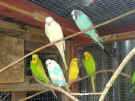 |
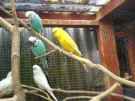 |
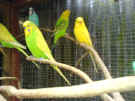 |
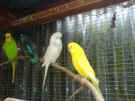 |
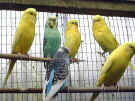 |
|
Albino
Cock, Blue Pied, Lutino, Normal Blue
+ Green Spangles |
Albino
(behind branch) Dbl Factor white, Lutino
+ 2 Blues. |
2 Green
Spangles, Green Opaline, Lutino + Blue |
Double
Factor White Cock next to Lutino Hen |
4
Lutinos + Rainbow + Dominant Blue Pied |
|
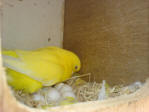 |
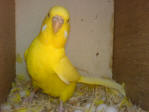 |
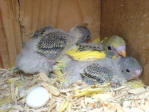 |
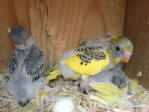 |
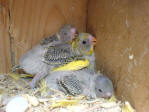 |
|
Lutino
Hen with 8 eggs |
Chicks
approx 3 weeks old - the eldest is a Pied |
The
pictures are "Thumbnails" - click on pictures inc. the one at the
top of the page and you will
see a bigger picture.
Press the
"Back" button to return to this page
●Pet
Birds
BREED INFO.
-
Budgies originate from Australia, as
do most of the small Parakeets we English tend to breed.
In the outback of Australia the wild
Budgie is always a "Normal Green" colour and much smaller than the
budgies we breed in captivity. It's only in captivity that we
manage to produce such diversity of shapes and sizes and the many variations
of colours. -
All the above pictures are of
"Pet" Budgies, as opposed to the specialist "Show"
quality Budgies that some Breeders produce and show up and down the Country.
-
The main difference is the size -
those of "Show" quality being much larger, esp. the head and the
"Necklace" - the black spots around the birds' throat.
-
The Show Breeders tend to titivate and
tart these spots even to the point of plucking out any
feathers that may
detract from a true-shaped big spot!
-
Pet Budgies can be an ideal bird for
the beginner to start out with.
^Top
FEEDING
-
They can thrive just on a Budgie mix
seed.
-
They originate from the
Desert areas of Australia where succulent foods are pretty much
non-existent.
They love Millet Sprays
(Panicum millet) but these are
quite fattening (so, should be given sparingly),
-
as are all the
bigger, shinier Pearl Millet seeds you find in your average Budgie
mixed seed,
-
which tends to have more millets than any other seeds.
-
However, if you mix a Budgie Tonic
Seed (which has a better mix of seeds a bit like mixed
canary seed + a
budgie seed) with Plain Canary seed you will get a much better selection of seeds
to help
keep your birds healthy.
-
TRILL Budgie seed
is supposed to be ideal, as it contains Iodine, which Budgies
must have in their Diet.
The seed husks must be blown off
the top of the seed dishes everyday before replenishing with
new seeds,
otherwise you could end up with a full dish of husks and rubbish and no seed
for your
birds to eat, if you just keep adding rather than de-husking first.
An
electric seed "Winnower" is ideal
to sort the husks from the good seed, thus not wasting seed and therefore
saving money!
-
Budgies love most green foods esp. chunks
of carrots, apples and celery which you can stab onto panel pins which you
can nail onto branches or shelves in the Aviary.
-
They thrive on clean wild foods too inc.
dandelion leaves, chickweed, dock seeds, shepherds purse, seeding grasses at
hay time.
-
When breeding they appreciate EMP/Witte
Mollen
(or similar) Egg
food slightly dampened either
with/without Sweetcorn added.
-
No bird likes sloppy food - just
slightly moist and crumbly.
You can overdose budgies on Calcium -
esp. at Breeding time
-
- so it's best NOT to add supplements which include
extra Calcium to any soft foods or water.
You are much safer just making sure
your Budgies have free access to Cuttlefish and Grit (mineralised/oystershell).
-
This will provide sufficient calcium for your budgies needs,
even at
Breeding time.
-
then they
take what they need, when they need it.
I once
saw a budgie hen, that had been
supplemented with extra calcium at breeding time, try to lay an egg and
end up
with a bad prolapse as it struggled to lay the egg - the poor thing had to be put to sleep.
Click
4 Budgies DO need IODINE in their
diets, so make sure you provide them with iodised mineral nibbles block (the small
square pink blocks you can buy from your Pet shop).
They must have fresh clean water every
day. In the summer make sure you
clean your water dishes and drinkers regularly, as they tend to
turn green & slimy,
when the sun's on them.
They do enjoy a bath - so make sure
you provide a dish or hanging bath of a size your budgie
can easily get into
to splash
about.
BUDGIES DO NOT NEED EXTRA CALCIUM SUPPLEMENTATION
-
They can get what they need
from Cuttlefish and Grit
-
As long as this is clean
and in sufficient quantity and quality.
-
- they take what they need,
when they need it.
-
- they also know how much
to take.
-
- they can't overdose
on cuttlefish and grit, as they instinctively know how much
to take on board and
self-regulate their intake.
-
At breeding times a hen
budgie can devour a lot of cuttlefish bone -which shows she
does need extra calcium
-
But this is her choice
and she will take what her body dictates it needs to form
the eggs inside her.
-
Therefore this is the
safest way to ensure Budgies get enough calcium in their
diets.
-
They do not need the extra
Calcium supplementation you can buy in powder or liquid form -
added to their water or soft foods - where they have no option
but to take it on board if they have a drink or eat the soft
foods.
-
I have seen one or 2 Discussion Forums
on the Internet, recently querying my statement, that Budgies Do
Not need Extra Calcium supplementation.
-
These people are saying
that budgies DO need extra calcium when breeding otherwise
they
take it from their own skeletal system (bones)
-
This I agree with :
what I am saying is that if you put extra calcium supplements in
their water or on their soft food, they have no option but take
it into their system, often with disastrous effects, as often it
is more than they need.
-
It is very easy to over-calcify
Budgies.
-
However, you must always
give the birds free access to Cuttlefish bone, mineralised grit
+ oyster-shell grit and iodine blocks.
-
There is sufficient calcium
available in Cuttlefish bone, mineralised grit + oystershell
grit for the average breeding budgies' needs - unless she has a
specific problem with soft-shelled eggs and then I would
question whether she should be breeding in the first place
as she obviously is not in full health and would poss need a
visit to an Avian vet for tests etc.
-
I hope this clarifies what
I was saying.
^Top
SEXING
-
In the normal colours of Budgie
telling the sexes apart is quite easy once they are a few weeks old.
-
The Cockbird has a
BLUE
CERE (the fleshy
bit above the beak).
-
The Hen has a
BROWN
CERE.
-
In the younger hen immature hen i.e.
under 4 months old - the Cere tends to be a
fawny-brown.
-
That doesn't mean to say you can breed
them after 4 months - they should be at least 8 months
- 1 year old
but ideally older, BEFORE they are allowed to breed.
-
As the Hen comes into Breeding
condition it's Cere darkens until it is a deep chocolate-brown colour.
-
With experience, you can actually sex
chicks while still in the Nest, as a Hen chick will nearly
always bite you and
make threatening noises
-
The cock chick is a lot milder
mannered - it may give you a nip if you handle it but nothing like the
"bite" the Hen chick will give you!!
-
The "Ino's" i.e.
Lutino
(yellow) and Albino (white) (the red-eyed varieties) are a little more
difficult to sex:
-
The "Ino" cockbird's
Cere is a pale "Baby-Blue
colour, even when Adult.
-
The Hen bird stays more
fawny but
does turn a much darker brown when Adult and in Breeding condition.
-
"Double Factor" Birds
(dominant colouration).
-
The "White" ones are
white all over and look like an Albino but have a strong blue
underlying
tinge to the feathers. They have dark eyes not the Red eye the Albino
has
-
- the cock birds have a normal deep blue Cere.
(See pictures at top of page).
-
The "Yellow Double Factors" are
similar to Lutinos but their colour is a stronger,
deeper
yellow.
^Top
BREEDING
-
When breeding Budgies everybody has
their own ideas and techniques which work for them.
-
Some Breeders start breeding before
Xmas, so that their birds have gone thru the moult ready for
the Showing
Season.
-
These Breeders usually have their
Birds housed indoors and use light dimmers etc., to simulate Spring conditions.
-
Other, non-competitive Breeders wait
until Spring-time which is when the birds will naturally come
into Breeding
condition. (Feb/March)
-
The cock and hen should be fully fit
and in Breeding condition. i.e. their Ceres should be bright blue
in the
cock bird and a chocolate brown in the Hen.
-
The Cock bird will start feeding the
hen.
-
They tend to bond and mate for life
but that doesn't mean that the cock doesn't try it on with other spare,
available hens when his mate is in the nest box!
-
Depending on whether you breed in
cages with one pair to a cage or en-colony with lots of Budgies together
in
an Aviary.
-
You get better results if a few
budgies are within sight and sound of each other.
-
They seem to like noise.
-
A Radio can be appreciated.
-
Don't get misled, as budgies are very
sociable birds and you often see cock budgies feeding another cock budgie -
it usually means nothing other than they are being sociable - it happens all
the time.
-
If you are breeding one pair to a cage
- you need a decent sized cage - min: 2ft 6" - 3ft long,
-
as budgies
are prone
to getting fat, if they are housed in too small an area.
-
they need
to be able to fly!
NESTBOXES
-
The Nest box can be added either onto
the front or side of the cage, depending on your set-up.
-
In an Aviary it is ESSENTIAL to make sure you have
quite
a few more Nest boxes than actual pairs
of birds, otherwise you will end up
with major fighting, which could be nasty.
-
The theory is to have
twice as many Nest boxes as pairs of birds but if you had 10 pairs then 14 -
16 boxes
should be o.k
-
Some Hens
spend more time chasing other hens out of each and every Nest
box instead of concentrating on claiming one for themselves and
getting it prepared to lay in!
^Top
ESSENTIAL
INFO ▼
This is why they should
all be as
near identical size and design to each other as possible
They will all try and claim the
highest -
There can be a lot of friction
(and sometimes injuries - even fatalities at times, if you aren't very
vigilant)
They can be quite cannibalistic when
it comes to territory! If Breeding en-colony - once the
pairs have claimed their Nest boxes and started to lay, you must NEVER EVER
introduce any new birds - this is asking for big trouble. -
SEE Important Notes on
NESTBOXES (Approx. 12" high x 6" square)
-
Budgies don't actually need any
bedding in the bottom of the Nest box but they must have a
wooden concave (like a
saucer) so that the eggs don't roll around and get chilled.
-
Also, so that chicks can get a
purchase when they push with their legs trying to move around.
-
If you don't have a concave with
shallow sides or a sprinkle (no
deeper) of
bedding
if the
nest box bottom is flat, you may end up with chicks with
Splayed
Legs.
-
A loose
Rule of Thumb, is that it's usually approx. 2 weeks from
putting birds together and
seeing them feed/mate to the first egg being
laid.
-
They
lay their eggs every other day
-
They
lay between 4
- 8 eggs
-
Hens
usually start
to incubate after the 2nd egg is laid.
-
The chicks will then hatch every other
day.
-
This is so
that in the wild they stand the chance of at least some of the
chicks surviving, if they are all of different ages, if there is
a draught or predator problems.
-
They can lay up to 3+ clutches every
year.
-
Any more than that, esp. if she brings
them all up, would deplete the Hen's calcium reserves and
not do her any
favours health-wise!
-
Over-breeding is a big No-No!
-
The Cock bird keeps guard of the nest
and feeds the hen while she is incubating.
-
He also helps to feed the chicks once
they hatch.
-
If anything did happen to the Hen, the
cock bird has been known to take over the feeding and rearing of the chicks
-
If the cock bird did not take over
the feeding and rearing then the only other options are adding the chicks to
another hen's nest if she has chicks of a similar age (so long as she hasn't
too many to start with).
-
or HAND-REAR - not an option to be
taken on lightly if you haven't done it before. (See page on Hand-rearing)
-
On another note: If anything happened
to the cockbird i.e. it dies/escapes - so long as it has mated at least once
with the hen, the sperm stays viable in the hen long enough to fertilise a
full clutch of eggs.
-
INCUBATION: approx. 18
days
-
CLOSED RING:
10 - 12 days - usually when eyes are about 1/2 open.
-
RING
SIZE:
L
-
FLEDGE: approx. 28
- 35 days
-
Once out of the nest the cock bird
tends to feed the chick up until it's fully independent.
DIET WHEN BREEDING
-
Budgies don't need a special diet when
Breeding.
-
Just a good quality seed and everything I've already mentioned
above.
-
They appreciate slightly dampened EMP
egg food (+ cooked sweetcorn, if you wish) when
feeding their chicks but they don't actually need anything other than their
usual seed diet + greenfoods, some fruit + veg (if u wish) etc.
-
Cuttlefish, GRIT (Oysershell
+ mineralised) iodine Blocks.
-
Obviously, fresh water.
^Top
PET BIRDS
Budgies are one of the
"original
companion Pet
Birds" kept in homes, going back centuries. -
Most people prefer the Cock Budgie, as
it can learn to talk, do Tricks and is much gentler, quieter and easier
to tame than
the Hen Budgie.
-
Adult HEN birds, esp out
of an Aviary do not make the best pets really.
-
They will tend to nip
(quite hard often) as this is what they do to protect their
nests when they breed.
-
Also, they more often than
not - do not talk - nothing like the cock-birds anyway.
-
I can always sex my
young chicks in the nest, even before they develop their
feathers -
-
When u pick them up : the
Hen chicks bite and the cocks don't - unless upset and then it's
nowhere near as hard as a hen will.
-
Hens mean it - Cock birds
just warn you
-
If you are buying a bird as
a Pet - you are best trying to get the bird just after it's
weaned off it's parents and eating for itself.
-
8 - 10 weeks would be an
ideal age
-
Much older than this and
they are that bit more difficult to tame as they are more
imprinted on their parents and siblings.
-
You can always tell a young
budgie
-
a) by it's eyes : a
Young bird has all dark eyes and an adult has the white area
around the iris
-
Unless it is an "ino" (Lutino/Albino)
- a red-eye - then it's more difficult.
-
b) by the "Bars" on it's
head - a Baby Budgie is called a "Barhead" because these
dark coloured "Bars" or lines on the top of the head extend down
to the forehead just above the eyes and completely cover the top
of the head.
-
As they get older the bars
at the front of the head start to fade
-
In an Adult they have
receded back - just like a "Bald Man's hairline"!!
-
So they have some at the
back of the head and down the back of the neck but the top is
usually a clear yellow or white depending if the bird is green
or blue.
-
All Pet Birds should be able and
allowed to take
plenty of flying exercise.
-
You are much better spending time
getting your bird used to you and accepting you BEFORE you
let it out
to fly Free.
-
If they are finger-tame all the
better, then you can get the bird back into it's cage safely with
as little
stress as possible.
-
If you can't get the bird back in
it's cage
-
You will give the bird major stress
if you do this and it could have a heart attack and even die of
fright or
you could badly injure it.
-
Be very aware the first time you
let your new pet out, as they always fly straight at and into the window, as
this looks like an open space to them.
-
Many Pets have ended up either
concussed or with broken necks after their first foray out, for just such a
reason, esp. the baby birds.
-
Always have something up at the
window - like net curtains or blinds etc.
-
On the reverse side of the coin -
always make sure ALL WINDOWS, Doors etc. are closed when
your pet
is free, as they are like grease-lightening and
will be thru. a gap before you know it!
-
Just be aware that all
"Parrot-like" birds will chew anything wooden or fabric, so watch
it at
all times while it is out of it's cage.
-
Make sure you don't have any
Poisonous
Plants in your house that your bird
could nibble.
-
Also, be
VERY AWARE that
PLUG-IN "GLADE-TYPE" of Air Fresheners are very TOXIC
to your birds and can
make them very ill and ultimately have been known to kill your
Pet esp. if New and the fumes are very strong
and close to where you keep your Pet Bird!
-
You should NEVER leave any Pet Bird
alone in the house for extended periods of time
- that's paramount to mental
cruelty!
-
Budgies love mirrors and will
"chatter" away to their reflections.
-
Also, they love
"stimulating" Toys and swings - but don't clutter their free space
- they need to
be able to move freely about, within their cages.
-
You are better only giving one or 2
toys at any one time then changing them, say weekly, to help
keep your bird
stimulated.
CAGES
-
Make
sure that at least 2 sides of the cage the Bars are Horizontal.
-
Budgies can't climb up Vertical
Bars and they need to be able to climb all round their cage.
-
Square or rectangular Cages are
acceptable but...
-
Round cages, esp. those with
vertical bars are a big No! No!
-
Another consideration is the
height and width of the cage.
-
Some cages, esp. those for the
bigger bird, have the top of the cage in 2 halves which open
separately.
-
The top opens out, so that you can
put a perch across the gap, then the bird can perch above it's own cage and
hopefully save your furnishings - it also will do it's droppings into it's
cage and not on
your floor!
-
All these things must be taken into
consideration when buying your Pet Bird's cage as it has to live
in it and
it must feel like a spacious home and not a prison!
-
Another thought is the cage door.
It's much
better if it opens downwards and doubles-up as a platform for the bird
to sit on as it comes out of it's cage.
-
If the door opens sideways there is
only the thin metal door frame for the bird to perch on to get in and out of
it's cage.
-
Natural branches are best as perches
- smooth dowel rods or ridged
plastic perches are not good for their feet. (See
Bumblefoot)
-
Sandpaper perch covers are just cruelty!!
-
Would
you like to stand with your bare feet on a perch covered in
sandpaper??
-
They need different widths of perch
to exercise their feet and their perches should be wide enough so that the
foot just sits on the top half of the perch and isn't so narrow that the
foot wraps all the way round it.
-
When you go out it's a good idea to
leave either a radio or television on for your Bird.
-
Better still, have another sociable,
non-threatening, Pet Bird
in a separate cage in the same room.
-
Never have your bird in a South
Facing window, where the sun can beat mercilessly on them, trapped in their
cages, during the summer months.
-
Your Pet can and will overheat.
-
During the heat of the day in the
wild, birds seek shade in cool areas of bushes and trees.
-
You never see a Bird outside
"Sunbathing" by choice!!
-
You may love the Sun but your bird
prefers shade and cool.
-
NEVER leave another Pet alone in the
room with your Pet Bird. Esp. a dog or cat!!
-
They do like to be covered over at
night and some will even let you know when they are ready to
"go to
Bed".
COLOURS
This
section to be expanded and added to . . . . .
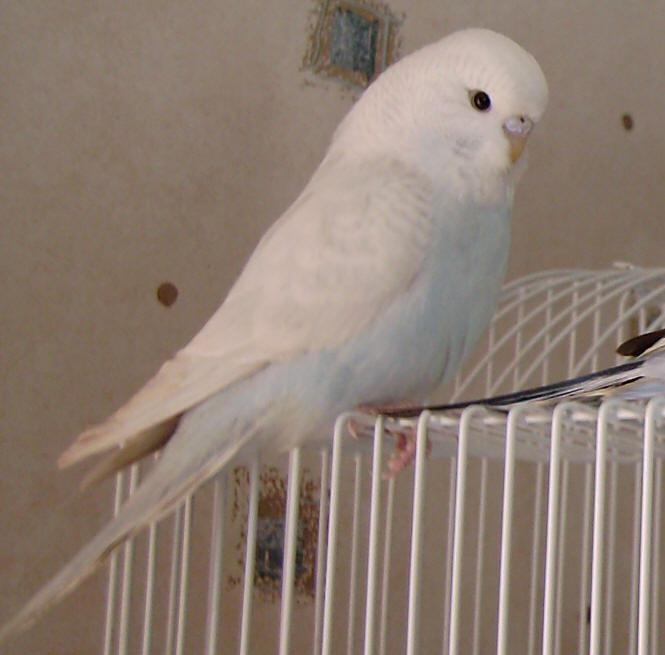
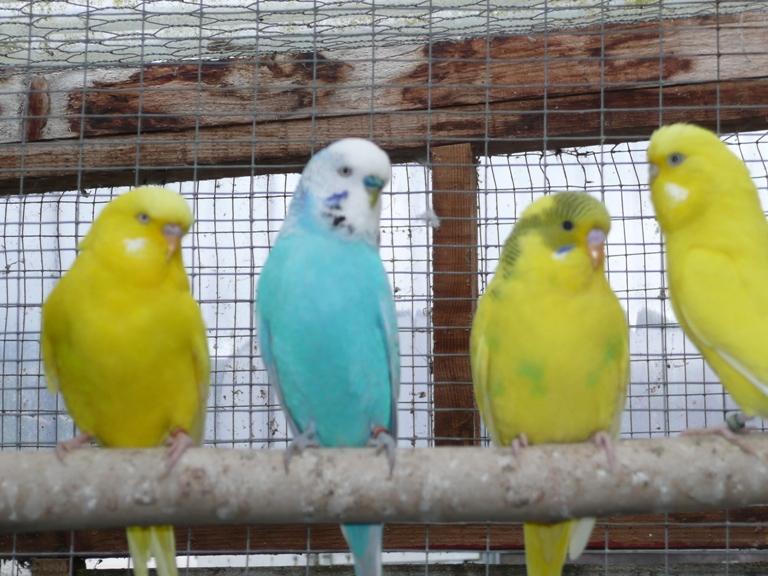
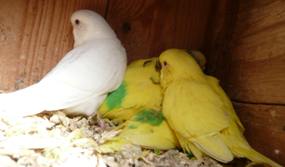
Baby "Double-factor White"
Lutino > Sky Blue > Double Factor Pied > Lutino
Albino > x2 Dominant pieds > Lutino Chicks - Nestmates
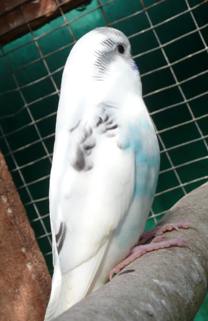 Link to the Budgerigar Society Webpage:
http://www.budgerigarsociety.com/budgerigars_for_beginners.asp
Link to the Budgerigar Society Webpage:
http://www.budgerigarsociety.com/budgerigars_for_beginners.asp
Double Factor Pied
A good Budgie site
http://www.officialbarrieshuttbudgerigars.com/index.htm
|